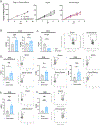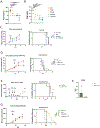Sensory nerve release of CGRP increases tumor growth in HNSCC by suppressing TILs
- PMID: 38423011
- PMCID: PMC10939743
- DOI: 10.1016/j.medj.2024.02.002
Sensory nerve release of CGRP increases tumor growth in HNSCC by suppressing TILs
Abstract
Background: Perineural invasion (PNI) and nerve density within the tumor microenvironment (TME) have long been associated with worse outcomes in head and neck squamous cell carcinoma (HNSCC). This prompted an investigation into how nerves within the tumor microenvironment affect the adaptive immune system and tumor growth.
Methods: We used RNA sequencing analysis of human tumor tissue from a recent HNSCC clinical trial, proteomics of human nerves from HNSCC patients, and syngeneic orthotopic murine models of HPV-unrelated HNSCC to investigate how sensory nerves modulate the adaptive immune system.
Findings: Calcitonin gene-related peptide (CGRP) directly inhibited CD8 T cell activity in vitro, and blocking sensory nerve function surgically, pharmacologically, or genetically increased CD8 and CD4 T cell activity in vivo.
Conclusions: Our data support sensory nerves playing a role in accelerating tumor growth by directly acting on the adaptive immune system to decrease Th1 CD4 T cells and activated CD8 T cells in the TME. These data support further investigation into the role of sensory nerves in the TME of HNSCC and points toward the possible treatment efficacy of blocking sensory nerve function or specifically inhibiting CGRP release or activity within the TME to improve outcomes.
Funding: 1R01DE028282-01, 1R01DE028529-01, 1P50CA261605-01 (to S.D.K.), 1R01CA284651-01 (to S.D.K.), and F31 DE029997 (to L.B.D.).
Keywords: CGRP; HNSCC; Preclinical research; TME; cancer; denervation; immunotherapy; radiation therapy; sensory nerves.
Copyright © 2024 Elsevier Inc. All rights reserved.
Conflict of interest statement
Declaration of interests S.D.K. receives clinical funding from Genentech that does not relate to this work. She receives clinical trial funding from AstraZeneca, a part of which is included in this manuscript. She also receives preclinical research funding from Roche and Amgen unrelated to this manuscript. R.W. serves in an advisory role for AstraZeneca.
Figures






References
-
- Brandwein-Gensler M, Teixeira MS, Lewis CM, Lee B, Rolnitzky L, Hille JJ, Genden E, Urken ML, and Wang BY (2005). Oral squamous cell carcinoma: histologic risk assessment, but not margin status, is strongly predictive of local disease-free and overall survival. Am J Surg Pathol 29, 167–178. 10.1097/01.pas.0000149687.90710.21. - DOI - PubMed
MeSH terms
Substances
Grants and funding
LinkOut - more resources
Full Text Sources
Medical
Research Materials

